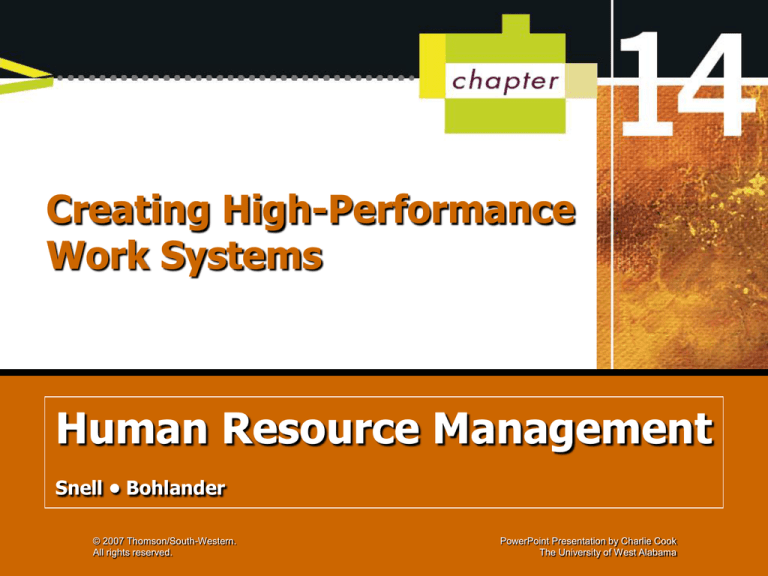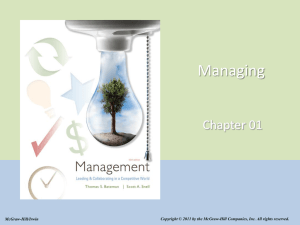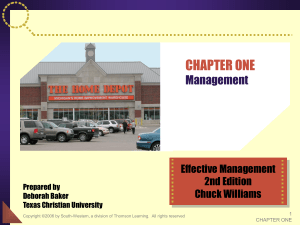
Creating High-Performance
Work Systems
Human
Resource
Management
Managing Human Resources
• Snell
SnellBohlander
• Bohlander
© 2007 Thomson/South-Western.
All rights reserved.
14th edition
PowerPoint Presentation by Charlie Cook
The University of West Alabama
Objectives
After studying this chapter, you should be able to:
1. Discuss the underlying principles of high-performance work
systems.
2. Identify the components that make up a high-performance
work system.
3. Describe how the components fit together and support
strategy.
4. Recommend processes for implementing high-performance
work systems.
5. Discuss the outcomes for both employees and the
organization.
6. Explain how the principles of high-performance work systems
apply to small, medium-sized, and large organizations.
© 2007 Thomson/South-Western. All rights reserved.
14–2
High-performance Work System (HPWS)
• A specific combination of HR practices, work
structures, and processes that maximizes
employee knowledge, skill, commitment, and
flexibility.
• Systems composed of many interrelated parts
that complement one another to reach the goals
of an organization, large or small.
© 2007 Thomson/South-Western. All rights reserved.
14–3
Figure 14–1
Developing High-Performance Work Systems
© 2007 Thomson/South-Western. All rights reserved.
14–4
Figure 14–2
Underlying Principles of High-Performance Work Systems
© 2007 Thomson/South-Western. All rights reserved.
14–5
Principles of HPWS
• The Principle of Shared Information
A shift away from the mentality of command and
control toward one more focused on employee
commitment.
Creating a culture of information sharing where
employees are more willing (and able) to work toward
the goals for the organization.
© 2007 Thomson/South-Western. All rights reserved.
14–6
Principles of HPWS (cont’d)
• The Principle of Knowledge Development
Employees in high-performance work systems need
to learn in “real time,” on the job, using innovative
new approaches to solve novel problems
The number of jobs requiring little knowledge and skill
is declining while the number of jobs requiring greater
knowledge and skill is growing rapidly.
© 2007 Thomson/South-Western. All rights reserved.
14–7
Principles of HPWS (cont’d)
• The Principle of Performance-Reward Linkage
It is important to align employee and organizational
goals. When rewards are connected to performance,
employees will naturally pursue outcomes that are
mutually beneficial to themselves and the
organization.
© 2007 Thomson/South-Western. All rights reserved.
14–8
Principles of HPWS (cont’d)
• The Principle of Egalitarianism
Egalitarian work environments eliminate status and
power differences and, in the process, increase
collaboration and teamwork.
When this happens, productivity can improve if
people who once worked in isolation from (or
opposition to) one another begin to work together.
© 2007 Thomson/South-Western. All rights reserved.
14–9
Figure 14–3
Anatomy of High-Performance Work Systems
© 2007 Thomson/South-Western. All rights reserved.
14–10
Complementary Human Resources Policies
and Practices
Training and
Development
Staffing Practices
© 2007 Thomson/South-Western. All rights reserved.
Compensation
14–11
Fitting It All Together
• Ensuring Internal fit
The situation in which all the internal elements of the
work system complement and reinforce one another.
• Establishing External fit
The situation in which the work system supports the
organization’s goals and strategies.
© 2007 Thomson/South-Western. All rights reserved.
14–12
Figure 14–4
Achieving Strategic Fit
© 2007 Thomson/South-Western. All rights reserved.
14–13
Highlights in HRM 1A
Diagnosing Internal Fit
The degree to which HR management subsystems work together harmoniously—the degree of “fit” and internal consistency
as a continuum from -100 to +100. Examples of the extremes and midpoints on that continuum are as follows:
-100: The two subsystems work at cross purposes.
0: The two subsystems have little or no effect on one another.
+100: Each subsystem is mutually reinforcing and internally consistent.
DNK: Don’t know or have no opinion.
Source: Brian Becker, Mark Huselid, and Dave Ulrich, The HR Scorecard (Cambridge, MA: Howard University Press, 2001).
© 2007 Thomson/South-Western. All rights reserved.
14–14
Highlights in HRM 1B
Testing Alignment of the HR System with HR Deliverables
Please indicate the degree to which the following elements of the HR system facilitate the HR
deliverables shown, on a scale of +100 to -100. Examples of the extremes and midpoints on that
continuum are as follows:
-100: This dimension is counterproductive for enabling this deliverable.
0: This dimension has little or no effect on this deliverable.
+100: This dimension significantly enables this deliverable.
DNK: Don’t know or have no opinion.
© 2007 Thomson/South-Western. All rights reserved.
14–15
Highlights in HRM 1C
Testing Alignment of HR Deliverables
Please indicate the degree to which the following elements of the HR system facilitate the HR
deliverables shown, on a scale of +100 to -100. Examples of the extremes and midpoints on that
continuum are as follows:
-100: This dimension is counterproductive for enabling this deliverable.
0: This dimension has little or no effect on this deliverable.
+100: This dimension significantly enables this deliverable.
DNK: Don’t know or have no opinion.
© 2007 Thomson/South-Western. All rights reserved.
14–16
Assuring HPWS Success
• Necessary Actions for a Successful HPWS:
Make a compelling case for change linked to the
company’s business strategy.
Make certain that change is owned by senior and line
managers.
Allocate sufficient resources and support for the
change effort.
Ensure early and broad communication.
© 2007 Thomson/South-Western. All rights reserved.
14–17
Figure 14–5
Implementing High-Performance Work Systems
© 2007 Thomson/South-Western. All rights reserved.
14–18
Figure 14–6
Building Cooperation with Unions
Source: The Conference Board of Canada.
© 2007 Thomson/South-Western. All rights reserved.
14–19
Benefits of HPWS
• Employee Benefits
Have more involvement in the organization.
Experience growth and satisfaction, and become
more valuable as contributors.
• Organizational Benefits
High productivity
Quality
Flexibility
Customer satisfaction.
© 2007 Thomson/South-Western. All rights reserved.
14–20
Navigating the Transition to HighPerformance Work Systems
• Build a Transition Structure
• Implementation of High-performance Work
• Incorporate the HR Function as a Valuable
Partner
© 2007 Thomson/South-Western. All rights reserved.
14–21
Evaluating the Success of the System
• Process audit
Determining whether the high-performance work
system has been implemented as designed:
Are employees actually working together, or is the term
“team” just a label?
Are employees getting the information they need to make
empowered decisions?
Are training programs developing the knowledge and
skills employees need?
Are employees being rewarded for good performance
and useful suggestions?
Are employees treated fairly so that power differences
are minimal?
© 2007 Thomson/South-Western. All rights reserved.
14–22
Evaluating the Success of the System
(cont’d)
• To determine if the HPWS program is
succeeding in reaching its goals, managers
should look at such issues as:
Are desired behaviors being exhibited on the job?
Are quality, productivity, flexibility, and customer
service objectives being met?
Are quality-of-life goals being achieved for
employees?
Is the organization more competitive than in the past?
© 2007 Thomson/South-Western. All rights reserved.
14–23
Outcomes of High-Performance Work
Systems
• Employee Benefits of HPWS Systems
More involved in work, more likely to be satisfied and
find that needs for growth are more fully met.
More informed and empowered, they are likely to feel
that they have a fuller role to play in the organization
and that their opinions and expertise are valued more.
Greater commitment comes from higher skills and
greater potential for contribution,
© 2007 Thomson/South-Western. All rights reserved.
14–24
Outcomes of High-Performance Work
Systems (cont’d)
• Organizational Outcomes and Competitive
Advantage
Higher productivity
Lower costs
Better responsiveness to customers
Greater flexibility
Higher profitability
© 2007 Thomson/South-Western. All rights reserved.
14–25
Achieving Sustainable Competitive
Advantage through Employees
Valuable
Rare
Characteristics
of Employees’
Competencies
Organized
© 2007 Thomson/South-Western. All rights reserved.
Difficult to Imitate
14–26
Key Terms
• external fit
• high-performance work
system (HPWS)
• internal fit
• process audit
© 2007 Thomson/South-Western. All rights reserved.
14–27







